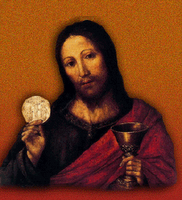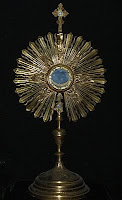Reminder, Remembrance, or What?
Q: I had a small gold tube made to be put onto a necklace. Inside it, I wish to place a small amount of consecrated bread and wine after they become the blood and body of Christ. I wish to wear this at all times, as a symbol of my faith and as a reminder to give to Him in prayer all that I have and all that I am. I also hope that it might evoke questions so I can share my faith by having someone ask and not trying to “push” my way in. Thank you.
A: I appreciate hearing of your faith and your desire to find a way to invite questions and begin conversations about our Lord. I share with you the belief that we certainly receive Christ’s body and blood in Holy Communion. Because I do, however, I don’t want to encourage your plan.
 Each record of the Last Supper in Matthew 26:26-29, Mark 14:22-25, Luke 22:14-22, and 1 Corinthians 11:23-26 clearly indicates that the Christ gives His body and blood as a meal. Granted, Jesus says that the eating and drinking is “in remembrance of” Him (Luke 22:19; 1 Corinthians 11:24-25). However, the remembrance occurs through our participation, not our observation.
Each record of the Last Supper in Matthew 26:26-29, Mark 14:22-25, Luke 22:14-22, and 1 Corinthians 11:23-26 clearly indicates that the Christ gives His body and blood as a meal. Granted, Jesus says that the eating and drinking is “in remembrance of” Him (Luke 22:19; 1 Corinthians 11:24-25). However, the remembrance occurs through our participation, not our observation.The Sacrament of the Altar “is the true body and blood of our Lord Jesus Christ under the bread and wine, instituted by Christ Himself for us Christians to eat and to drink. (Small Catechism)” This echoes the apostolic admonition: “For as often as you eat this bread and drink the cup, you proclaim the Lord's death until he comes. (1 Corinthians 11:26)”
 Non-scriptural uses of the Sacrament are scattered throughout history. The Church — specifically Roman Catholicism — started using the consecrated elements as a display. They invented Corpus Christi (“body of Christ”) festivals and created special devices such as monstrances or ostensoria to display consecrated hosts. The Reformation decried such practices, urging a return to eating and drinking according to the Lord’s Word.
Non-scriptural uses of the Sacrament are scattered throughout history. The Church — specifically Roman Catholicism — started using the consecrated elements as a display. They invented Corpus Christi (“body of Christ”) festivals and created special devices such as monstrances or ostensoria to display consecrated hosts. The Reformation decried such practices, urging a return to eating and drinking according to the Lord’s Word.In the medieval Church, the clergy discovered that people sometimes carried out from church part or all of their consecrated hosts (bread). Usually, it was superstition led these folks to bring it home to doctor sick relatives — or livestock! To counter this, the priests began feeding people directly, hand to mouth, and waiting to make sure that they chewed and swallowed before moving on.
 So I urge you to take your “remembrance” into yourself, carrying Christ’s body and blood within rather than without. Let your “display” or “conversation piece” be your words and deeds. If you seek also a physical image to aid in your witness, I would recommend instead a crucifix, a shell to signify Holy Baptism, an image of communion’s elements, such as grapes and wheat or chalice and host, or some other representation.
So I urge you to take your “remembrance” into yourself, carrying Christ’s body and blood within rather than without. Let your “display” or “conversation piece” be your words and deeds. If you seek also a physical image to aid in your witness, I would recommend instead a crucifix, a shell to signify Holy Baptism, an image of communion’s elements, such as grapes and wheat or chalice and host, or some other representation.See also the earlier post Leftover Communion Elements.
Explanation of the Sacrament of the Altar quoted from The Book of Concord, a public domain text.
Scripture quoted from The Holy Bible, English Standard Version™, © 2001 by Crossway Bibles.
Send email to Ask the Pastor.
Walter Snyder is a Lutheran pastor, conference speaker, author of the book What Do Lutherans Believe, and writer of numerous published devotions, prayers, and sermons.
Technorati Tags: Holy Communion | Lord’s Supper | Communion | Eucharist | wine | bread | body | blood | remainder | leftovers | take, eat | take, drink | monstrance | ostensorium | Lutheran | Lutheranism | Christian | Christianity | theology | systematic theology | dogmatics | sacramental theology | exegetical theology | exegesis | practical theology | Pastor Walter P. Snyder | Walter Snyder | Ask the Pastor
Newspaper column 574:1

0 Comments:
Post a Comment
<< Home